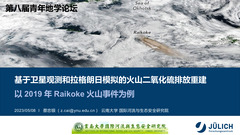Improved estimation of volcanic SO2 injections from satellite observations and Lagrangian transport simulations: the 2019 Raikoke eruption
编号:2311
稿件编号:747 访问权限:私有
更新:2023-04-25 17:35:23
浏览:744次
特邀报告
摘要
Monitoring and modeling of volcanic plumes are important for understanding the impact of volcanic activity on climate and for practical concerns, such as aviation safety or public health. Here, we apply the Lagrangian transport model Massive-Parallel Trajectory Calculations (MPTRAC) to estimate the SO2 injections into the upper troposphere and lower stratosphere by the eruption of the Raikoke volcano (48.29∘ N, 153.25∘ E) in June 2019 and its subsequent long-range transport and dispersion. First, we used SO2 retrievals from the AIRS (Atmospheric Infrared Sounder) and TROPOMI (TROPOspheric Monitoring Instrument) satellite instruments together with a backward trajectory approach to estimate the altitude-resolved SO2 injection time series. Second, we applied a scaling factor to the initial estimate of the SO2 mass and added an exponential decay to simulate the time evolution of the total SO2 mass. By comparing the estimated SO2 mass and the mass from TROPOMI retrievals, we show that the volcano injected 2.1 ± 0.2 Tg SO2, and the e-folding lifetime of the SO2 was about 13 to 17 d. The reconstructed SO2 injection time series are consistent between using the AIRS nighttime and the TROPOMI daytime products. Further, we compared forward transport simulations that were initialized by AIRS and TROPOMI SO2 products with a constant SO2 injection rate. The results show that the modeled SO2 change, driven by chemical reactions, captures the SO2 mass variations from TROPOMI retrievals. In addition, the forward simulations reproduce the SO2 distributions in the first ∼10 d after the eruption. However, diffusion in the forward simulations is too strong to capture the internal structure of the SO2 clouds, which is further quantified in the simulation of the compact SO2 cloud from late July to early August. Our study demonstrates the potential of using combined nadir satellite retrievals and Lagrangian transport simulations to further improve SO2 time- and height-resolved injection estimates of volcanic eruptions.
Monitoring and modeling of volcanic plumes are important for understanding the impact of volcanic activity on climate and for practical concerns, such as aviation safety or public health. Here, we apply the Lagrangian transport model Massive-Parallel Trajectory Calculations (MPTRAC) to estimate the SO2 injections into the upper troposphere and lower stratosphere by the eruption of the Raikoke volcano (48.29∘ N, 153.25∘ E) in June 2019 and its subsequent long-range transport and dispersion. First, we used SO2 retrievals from the AIRS (Atmospheric Infrared Sounder) and TROPOMI (TROPOspheric Monitoring Instrument) satellite instruments together with a backward trajectory approach to estimate the altitude-resolved SO2 injection time series. Second, we applied a scaling factor to the initial estimate of the SO2 mass and added an exponential decay to simulate the time evolution of the total SO2 mass. By comparing the estimated SO2 mass and the mass from TROPOMI retrievals, we show that the volcano injected 2.1 ± 0.2 Tg SO2, and the e-folding lifetime of the SO2 was about 13 to 17 d. The reconstructed SO2 injection time series are consistent between using the AIRS nighttime and the TROPOMI daytime products. Further, we compared forward transport simulations that were initialized by AIRS and TROPOMI SO2 products with a constant SO2 injection rate. The results show that the modeled SO2 change, driven by chemical reactions, captures the SO2 mass variations from TROPOMI retrievals. In addition, the forward simulations reproduce the SO2 distributions in the first ∼10 d after the eruption. However, diffusion in the forward simulations is too strong to capture the internal structure of the SO2 clouds, which is further quantified in the simulation of the compact SO2 cloud from late July to early August. Our study demonstrates the potential of using combined nadir satellite retrievals and Lagrangian transport simulations to further improve SO2 time- and height-resolved injection estimates of volcanic eruptions.
关键字
volcanic SO2,Lagrangian transport simulations






发表评论